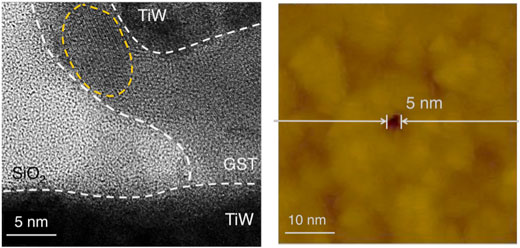| Dec 31, 2018 | |
New version of memory could power AI phones, smart devices |
|
| (Nanowerk Spotlight) For the first time, researchers from Singapore University of Technology and Design and University of Cambridge, have successfully developed a new version of phase-change memory that reduces the switching time and allows memory cells to produce excellent stability. | |
| “The new type of phase-change memory can be as fast as state-of-the-art RAM chips being considered to power artificial intelligence (AI) in phones, and it could also be used to power a range of other smart devices,” said Assistant Professor Desmond Loke, one of the scientists in the research team. | |
| The new version of phase-change memory, described in December 3 online edition of ACS Applied Materials and Interfaces ("Ultrafast Nanoscale Phase-Change Memory Enabled by Single-Pulse Conditioning"), could be manufactured with a cheap process: The procedure uses a normal voltage pulse and requires no additional special materials. | |
 |
|
| Transmission electron microscope image of a memory cell with single shot treatment, showing crystals are formed around the glassy area when single pulse is used (left panel). Atomic force microscope image of the pore of memory cell, used to switch the material (right panel). | |
| In traditional phase-change memory, the material can be switched between the glassy amorphous and crystalline ordered states that show distinct differences in physical characteristics, for example, electrical conductance. A few years ago, the team used multiple constant low voltages to reduce the switching time. | |
| In the latest work, the team focused on improving the method, and the technology allows for even further reduction of the switching time. To achieve that, the researchers created a single high amplitude voltage pulse, and moderate duration otherwise called shot, to produce favorable atomic rearrangement in a material. | |
| Because melting and quenching in the central region of a cell can occur followed closely by crystallization which is separated spatially from the center. The crystal growth rate can also be slower at lower temperatures. | |
| The team found that incorporating the single shot pulse reduces the switching time to 400 picoseconds, and allows cells to produce high stability of the glassy state. The combined time to switch the material is longer than currently available RAM chip, but “we expect them to be able to go much faster,” Loke said. | |
| Authors of the ACS Applied Materials and Interfaces paper are Desmond Loke, Jonathan Skelton, Tae Hoon Lee, Rong Zhao, Tow-Chong Chong and Stephen Elliott. | |
|
Provided by Singapore University of Technology and Design as a Nanowerk exclusive
|
|
|
Become a Spotlight guest author! Join our large and growing group of guest contributors. Have you just published a scientific paper or have other exciting developments to share with the nanotechnology community? Here is how to publish on nanowerk.com. |
|
